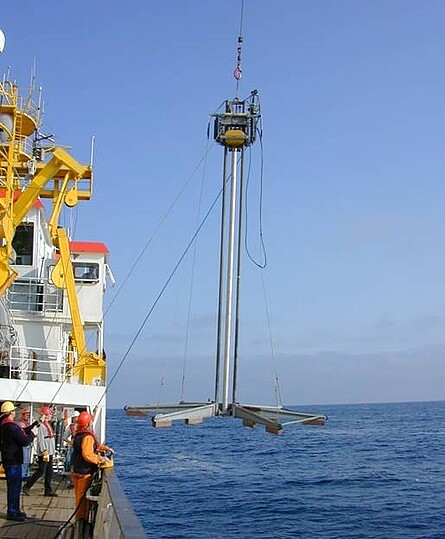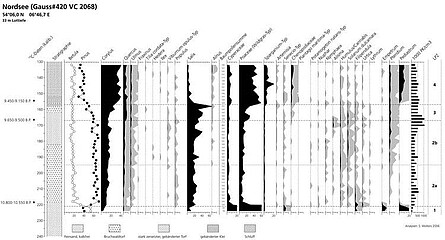Palynological and Geochemical Studies towards a Reconstruction of the Early Holocene Sea Level Transgression in the North Sea
The study of the Holocene sea level transgression in the southern North Sea is one of the fundamental objectives pursued by the NIhK since its foundation in the late 1930ies. In 2003, an appraisal of the data collected during the 20th century was summarised by Behre in the form of a sea level chart of the southern North Sea. Despite an excellent set of data for the past 3000 years and a sufficiently good one for the past 6000 years, there is only a small number of surveys which retrieved sediments of the sea level transgression in the Early Holocene. Through cooperation with the BSH, Hamburg, and the BGR, Hanover, the NIhK had access to peat from several North Sea core samples which were intended to overcome this lacuna. The following presents the results of Dr. Steffen Wolters’ (NIhK) analysis of core sample VC 2068 (54°06,0 N; 06°46,7 E; 33 m depth of water), which was retrieved during ground investigations by BSH. The 70 cm of peat preserved in the core sample are likely to represent the thickest submarine Holocene peat encountered in the North Sea to date.
The peat’s formation during the Boreal is clearly evident from the high Pinus readings and the increasing curves for Corylus and Quercus. The low values for Alnus show that peat growth came to an end before the beginning of the Atlantic period. Three radiocarbon determinations confirm the palynological phasing.
The absence of Tilia and the late increase of Corylus are of significance from an immigration history point of view. There is, however, little opportunity for comparison with other studies since there are no pollen diagrams from the East Frisian littoral providing satisfactory resolution for the Early Holocene. The only comparison is the study of Boreal peat from a core sample retrieved from the Austerngrund, located some 85 nmi to the WSW (Behre 1984). Consequently, the details of the exact timing of immigration and mass spread of some indigenous deciduous trees in the area of the modern North Sea remains as yet largely obscure.
Peat growth started during the Early Boreal with the formation of a peat bog caused by an increasing ground water level on Pleistocene sand. Base-rich ground water was conducive to the formation of a eutraphent carr-vegetation, which could only lead to the formation of willow carrs on account of the lack of Alnus. The latter is evidenced by high values of Salix and frequent finds of Salix wood fragments.
Peat sedimentation stopped around 9300 cal BP. There was thus a window of between 1100 and 1600 years for the formation of peat, from its initiation by the transgression-induced rise in ground water level to the flooding of the fen by the sea. In the pollen diagram the stratigraphic contact between peat and clay is marked by an increase in pollen of Poaceae and Chenopodiaceae. These plants are representative of the salt meadow vegetation, i.e. Salicornia meadows and/or of common/Atlantic saltmarsh-grass lawns at slightly higher elevations, which can be found in the region of the mean high water.
Bibliography
Behre, K.-E., 2003: Eine neue Meeresspiegelkurve für die südliche Nordsee. Transgressionen und Regressionen in den letzten 10.000 Jahren. Probleme der Küstenforschung im südlichen Nordseegebiet, 28 9-63.
Behre, K.-E., Dörjes, J., Irion, G., 1984: Ein datierter Sedimentkern aus dem Holozän der südlichen Nordsee . Probleme der Küstenforschung im südlichen Nordseegebiet, 15, 135-148.
Wolters, S., 2006: Pollenanalytische und geochemische Untersuchungen an submarinen Torfen zur Rekonstruktion des frühholozänen Meeresspiegelanstiegs in der Nordsee. In: 15. Jahrestreffen des Arbeitskreises Vegetationsgeschichte der Reinhold-Tüxen-Gesellschaft, Karlsruhe, 20-23 Oktober 2006, Kurzfassungen der Vorträge und Poster, S. 24-25.
Wolters, S., 2009: Torf vom Meeresgrund – Schlüssel zur Naturgeschichte der Nordsee. Archäologie in Deutschland, 6/2009: 22-25.
Wolters, S., 2009: Neue Daten zur Vegetationsgeschichte der südlichen Nordsee. Pollenanalytische Untersuchungen an in-situ Torflagern und Torfgeröllen. Nachrichten des Marschenrates zur Förderung der Forschung im Küstengebiet der Nordsee, 45/2008: 53-57.
Wolters, S., Zeiler, M., Bungenstock, F. (2010): Early Holocene environmental history of sunken landscapes: pollen, plant macrofossil and geochemical analyses from the Borkum Riffgrund, southern North Sea. International Journal of Earth Sciences, 99(8):1707-1719.


